6 Years of Digital Camera Features
Introduction
Nikon announced in September 2010 their new flahship fixed-lens digital camera, the Coolpix P7000. This is an advanced compact camera with a 7X wide-angle optical zoom lens, a full suite of photographic controls with plenty of external controls and a viewfinder. Digital cameras such as these have been making a comeback recently in the form of the Canon Powershot S90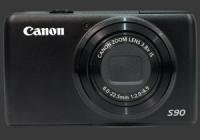
Canon Powershot S90 and Canon Powershot G11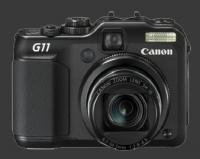
Canon Powershot G11 which were recenly upgraded to the S95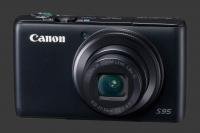
Canon Powershot S95 and G12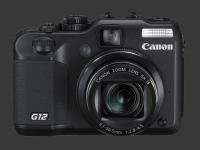
Canon Powershot G12 respectively. Since entry-level DSLRs are similarly priced, advanced compact cameras have a tough time selling at enough volume lately.
What is interesting from an evolution point-of-view is that the Nikon Coolpix P7000's specifications are incredibly similar to the 6 years old Konica-Minolta Dimage A2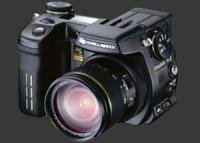
Konica-Minolta Dimage A2, the best-designed fixed-lens cameras ever made and still one of the most sophisticated, something which Fuji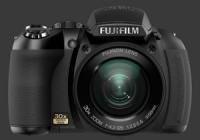
Fujifilm Finepix HS10 claims to have topped. Read on to find out how far 6 years of digital camera innovation has brought us!
Features & Ergonomics
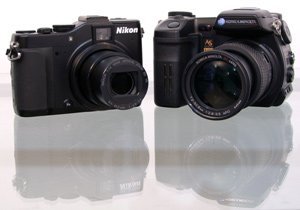 Starting with the similarities, we have two digital cameras with:
Starting with the similarities, we have two digital cameras with:
- 8 or 10 megapixels
- 7X optical zoom, equivalent to 28-200mm in 35mm terms
- Image stabilization
- Full manual controls, including manual-focus
- Custom white-balance with fine-tuning
- Several metering modes
- Dual control dials
- Tunable image parameters
- JPEG, RAW & RAW+JPEG shooting
- Single, Continuous and Tracking focus
- Plenty of external controls
- A hot-shoe for add-on flash
- Accessory lens support
- Remote control support
There are certainly a great deal of differences in terms of specifications as well, the most notable difference being the size. If one thing has keep evolving among electronics, it is miniaturization. Both cameras have roughly the same width and height but depth of the P7000 is almost 3 times lessCompare 45mm for the P7000 to 114mm for the A2. Two other things that have been rapidly improving for digital cameras are ISO sensitivities and video capabilities. As expected, the P7000 is ahead of the A2 on both fronts: The Konica-Minolta A2 reach ISO 800, while the Nikon P7000 reaches ISO 6400; The A2 captures video at the odd resolution of 544x408 which is not even VGA and the P7000 shoots 720p HD video with stereo sound. The P7000 even has an input jack for an external stereo microphone.
There is an increase of resolution between the two with the P7000 having 25% more pixels and reaching 10 megapixels using a sensor which is actually smaller than the A2's 8 megapixels one. The lens may have the same focal-range but the A2's has a mechanically-linked zoom which makes it infinitely precise and much faster to operate. It also has a brighter aperture at the long end.by 1½ stops. Both lenses start at F/2.8 at 28mm but the A2's only closed down to F/3.5 at 200mm while the P7000 goes down to F/5.6. Another bonus for the A2 is a fly-by-wire focus ring which makes manual focusing efficient and also allows Direct Manual-FocusDMF - AKA Quick-shift autofocus, something which is otherwise only available on some DSLR lenses.
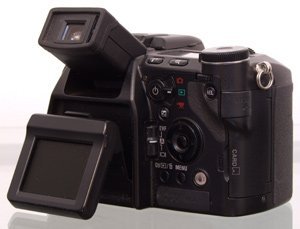 Viewing has changed quite a bit between these two. The LCD has almost doubled in size, from 1.8" to 3". It has almost increased by 8 times in terms of resolution with 113K pixels versus 920K pixels. This change makes composing with the P7000's LCD much more comfortable, unless you just happen to need the tilting capability of the A2's. Coverage has gone down in this case, although most modern cameras show 100% coverage on their LCDs. The viewfinder is completely different though. The P7000 has an optical tunnel viewfinder which zooms in parallel with the lens and shows a paltry 64% of the frame, making it just about useless. On the other hand, until quite recently, the A2 has the very best EVF. With a resolution of 920k pixels, it shows a clear bright view with full heads up display and proper exposure-priority view. This A2's EVF is exemplary of what Live-View should be and previews color, exposure, white-balance all while showing 100% coverage. In low-light, the A2 can show a amplified B&W view as well. Plus, the eye-start sensor next to the EVF is a pleasure to have and quickly switches between the LCD and EVF without user-intervention. Finally, the EVF protrudes the back of the camera for added comfort and and tilts upwards up to 90°.
Viewing has changed quite a bit between these two. The LCD has almost doubled in size, from 1.8" to 3". It has almost increased by 8 times in terms of resolution with 113K pixels versus 920K pixels. This change makes composing with the P7000's LCD much more comfortable, unless you just happen to need the tilting capability of the A2's. Coverage has gone down in this case, although most modern cameras show 100% coverage on their LCDs. The viewfinder is completely different though. The P7000 has an optical tunnel viewfinder which zooms in parallel with the lens and shows a paltry 64% of the frame, making it just about useless. On the other hand, until quite recently, the A2 has the very best EVF. With a resolution of 920k pixels, it shows a clear bright view with full heads up display and proper exposure-priority view. This A2's EVF is exemplary of what Live-View should be and previews color, exposure, white-balance all while showing 100% coverage. In low-light, the A2 can show a amplified B&W view as well. Plus, the eye-start sensor next to the EVF is a pleasure to have and quickly switches between the LCD and EVF without user-intervention. Finally, the EVF protrudes the back of the camera for added comfort and and tilts upwards up to 90°.
While on the A2's side, it is worth noting that the interface and ergonomics of the Konica-Minolta A2 are still vastly superior. Luminous Landscape called it a Photographer's camera and it is. Obviously, its larger size helps, particularly by having a deep hand-grip, but there are far more subtleties:
- Both control wheels are accessible effortlessly without shifting your grip of the camera. The mode-dial can also be rotated with the thumb.
- The control-dials are put to excellent use allowing to change settings with one and refine it with the other. For example, front dial choose the drive mode such as self-timer and the rear selects its duration or one wheel choose the white-balance and the other fine-tunes it.
- The quick-menu dial operates with a heads-up view rather than activating a menu screen.
- Information and display settings are highly customizable, so you do not have to cycle over unwanted display options.
- There is an automatically illuminated status screen to check camera settings.
- Nearly all photographic parameters can be operated at eye-level.
- The live-histogram works will all exposure-modes.
- There is a one-touch custom white-balance button.
- The AE-L button can use the spot-metering instead of the current mode. It can also work as a toggle.
- The 2s self-timer does not reset itself after each use, making photography from a tripod quicker.
- A grip sensor senses when you are holding the camera and optionally activates autofocus.
Ergonomically, the P7000 is quite good, particularly considering its size. It does have a slight grip and the upper control-dial, exposure-compensation dial and AE-L/AF-L button are within easy reach. Among compact digital cameras it is one of the larger ones and has more buttons than most including two somewhat customizable buttons. The Fn button is of little use since all it does it temporarily set one chosen parameter to its default, such as ISO to Auto, when used with the shutter. It can be used with the zoom controller as well to make it even less continuous. The Av/Tv button can act as a toggle for multiple settings. One good handling improvement is that the P7000, like many modern camera, is shooting-priority. In the time of the A2, many had dedicated Playback modes. The A2 has a Quickview features which is essentially a shooting-priority view which gives you access to everything but the Playback menu which is needed for format the memory-card.
The P7000 is equipped with many modern-day features that did not exist when the A2 was produced:
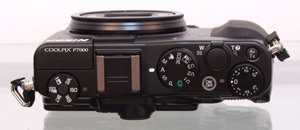 Dual-Axis Digital Level
Dual-Axis Digital Level- Adaptive-Lighting
- Face-Detection
- Blink-Detection
- Motion-Detection
- Scene-Mode Detection
- Reduced-Resolution High-ISO Mode
The Nikon P7000 also has some improved features like 2-axis white-balance fine-tuning and 5-shot exposure bracketing. The Konica-Minolta A2 can only bracket 3 images but can also bracket contrast, saturation and hue. They can both do time-lapse and continuous shooting, although only the A2 can do the latter for RAW images. The optional remote is wired for the A2 and infrared for the P7000.There are 2 more user-memories on the A2 than on the P7000.
The A2 has a few major features not found on the P7000:
- Depth-of-field Preview
- Wireless flash control
- Pre-Flash and ADI metering
- Computer Control Protocol
All this shows that in 6 years digital cameras have shrunk in size, reached much higher ISOs, started capturing HD video and the viewing experience has changed enormously. The price to pay for compactness is lesser ergonomics and controls. Indeed, both mechanical-zooms and fly-by-wire focusing are even more rare these days than they were back then. The demise of Konica-Minolta too caused the loss of some of the best camera designers. Several technologies they invented live-on though, the most notable one being CCD-shift stabilization. One hopes that after all this time, image quality and performance has dramatically improved and that is the topic of the next section.
Please Support Neocamera
All information on Neocamera is provided free of charge yet running this website is a huge endeavor. Purchases made via affiliate links found throughout the site help keep it running and up-to-date. There is no additional cost to you, so please consider buying via these links to our affilates:
If you found any information on this site valuable and did not purchase via our affiliate links, please considering donating via PayPal:
Any amount will be greatly appreaciated. Thank you for your support!
Updates
2024.04.03

Fujifilm X-T5 Review
Newest Fujifilm flagship boasting a 40 MP APS-C sensor, 5-axis IBIS with 7-stop efficiency, 15 FPS continuous drive, 6.2K Video capture, dual control-dials and dual SDXC UHS-II slots in a sturdy weatherproof and freezeproof body.
2023.11.20

Best Digital Cameras of 2023
Find out which are the Best Digital Cameras of 2023. All the new Mirrorless Digital Cameras from entry-level to high-end professional.
2023.07.10

Fujifilm X-H2 Review
40 Megapixels APS-C Hybrid Mirrorless Digital Camera with 7-stop IBIS. Fastest shutter ever and 8K video capture. Large builtin EVF with 0.8X magnification and 5.8 MP, plus an Eye-Start Sensor. Packed with features and large number of controls in a weatherproof and freezeproof body.
2023.05.07

Sony FE 20-70mm F/4G Review
Review of the unique Sony FE 20-70mm F/4G lens. The optical zoom of this lens spans ultra-wide-angle and medium focal-length coverage, making it one of the most versatile Full-Frame lenses on the market.
2023.01.15

Huion Inspiroy Dial 2 Review
Review of the Huion Inspiroy Dial 2 tablet, a medium sized drawing surface with dual dials and customizable buttons. Connects via USB-C or Bluetooth 5.0 with Windows, Linux and Android support.
2022.12.08

How to Pack for a Photo Trip
Find out how to pack for a travel photography trip, carry your gear safely while meeting airline regulations.
2022.11.13

Best Digital Cameras of 2022
The best digital cameras of 2022. A short list of the most outstanding models in their respective categories. Choose one for yourself or as a gift.
2022.09.21

Pentax DA* 60-250mm F/4 SDM Review
Review of the Pentax DA* 60-250mm F/4 SDM, the constant-aperture telephoto zoom with the highest zoom-ratio on the market.
2022.09.20

Pentax DA* 50-135mm F/2.8 SDM Review
Review of the Pentax DA* 50-135mm F/2.8 SDM, the lightest professional telephoto zoom native to the K-mount.
2022.09.10

Pentax DA* 11-18mm F/2.8 DC AW Review
Review of the Pentax DA* 11-18mm F/2.8 DC AW, the widest professional ultra-wide zoom native to the K-mount.
2021.11.24

50 Gifts Under $50 For Photographers in 2021
50 Gifts photographers will love. All for under $50 USD. 2021 Edition.
2021.11.17

Best Digital Cameras for 2021
Neocamera shows which are the very best Digital Cameras for 2021 in every category: Mirrorless, DSLR, Premium Compact, Ultra-Zoom and Rugged.
2024.04.03
2023.11.20
2023.07.10
2023.05.07
2023.01.15
2022.12.08
2022.11.13
2022.09.21
2022.09.20
2022.09.10
2021.11.24
2021.11.17
NEWS
2024.04.24

Megadap Ultimate Canon EF to Nikon Z Adapter
2024.04.24

Sony Custom Grid License
Technology
2024.04.16

Sony Launches Bright Ultra-Wide Compact Zoom
Lens
2024.03.27

Sigma Ultra-Bright Normal Mirrorless Lens
Lens
2024.03.27

Nikon Launches Full-Frame Super-Zoom Lens
Lens
2024.03.20

New Lens Statistical Comparisons
2024.03.14

Fujifilm Brings New Features to Instax Series
Instant Camera
2024.03.07

Leica Launches SL3 Full-Frame Mirrorless
Digital Camera
2024.02.22

Panasonic Unveils Full-Frame Travel-Zoom Lens
Lens
2024.02.21

Sigma Reveals 2 Extreme Full-Frame Lenses
Lens
2024.02.21

Sony Reveals Bright Compact Full-Frame Zoom
Lens
2024.02.20

Venus Launches First Autofocus Lens
Lens







